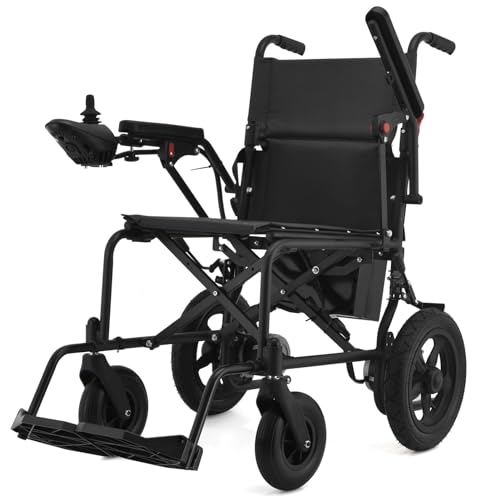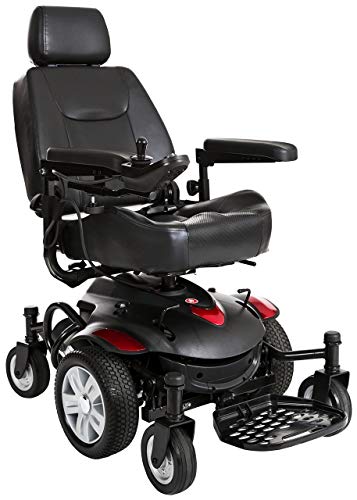Electric Wheelchair With Joystick It's Not As Hard As You Think
페이지 정보
작성자 Alonzo 작성일24-09-22 02:00 조회7회 댓글0건관련링크
본문
 discount electric wheelchairs Wheelchair With Joystick
discount electric wheelchairs Wheelchair With Joystick Joysticks in power wheelchairs can significantly improve independence and ease of use. However, standard joysticks might be incompatible with the individualized features of hand dysfunction.
Joysticks in power wheelchairs can significantly improve independence and ease of use. However, standard joysticks might be incompatible with the individualized features of hand dysfunction.This study examined the efficacy and satisfaction of customized power wheelchair joysticks fabricated with 3D printing technology. The evaluation was conducted using the modified power-mobility inside driving assessment (PIDA), National Aeronautics and Space Administration Task Load Index and Psychosocial Impact of Assistive Devices Scale.
Control
The control system of a power wheelchair comprises two essential components which are the joystick as well as the electronics (also known as the controller). Standard joysticks often mount to the left or right side of the chair. However, more sophisticated rehab chairs might have swing away mounts that allow the joystick to be moved to the centre of the seat.
The manner in which a joystick can be placed and operated will play a crucial role in determining whether it will be a success for a specific user. For instance when a person suffers from severe tremors, it is crucial to ensure the joystick is constructed in such a way that these movements will not trigger accidental activations of the chair. The standard EPW joysticks typically use proportional input devices that respond to the level of deflection on the gimbal in order to control the movement of the chair (similar to an automobile accelerator pedal or video game controller).
There are a myriad of alternatives to control options for power wheelchairs that require a minimum of force to activate. Switch controls, sip-and-puff controls head arrays, sip-and-puff controls, and chin controls are all accessible. While some of these specialty controls require a separate interface to connect them to the wheelchair, a lot are compatible with the latest generation of joysticks that have incorporated Bluetooth into their handles.
Some standard wheelchair joysticks have screens to display the state of the system and to provide feedback to the users. This is particularly useful for those who are cognitively or visually impaired. Other advanced joysticks have the ability to control a variety of accessories like environmental controls, and even a TV or tablet.
No matter what technology is used, a joystick can only be as effective if it is comfortable for the user to operate. This is why it is crucial to think about the size and position of the buttons on a joystick to ensure they are easy to access. It is also important to consider the sensitiveness of the joystick which can be adjusted to a variety of levels based on the needs of each individual client.
Comfort
A joystick-controlled powerchair wheelchair offers many benefits that aren't accessible with manual chairs. They minimize fatigue triggered by operational factors and allow for longer travel distances over manual wheelchairs. They can also be used in places that are smaller and have more difficult terrain than a manual one, for example, uneven surfaces or slopes in the outdoors. With this added freedom users can enjoy the freedom of movement that brings new life to their lives and reminds users of the feeling to be independent once more.
A variety of different power wheelchairs are available in many options. The number of bells and whistles available on the particular model will be contingent on the needs of the user and desires. The most commonly used features are:
Controls on an electric wheelchair that have a joysticks can be modified to meet the needs of each individual. This includes the kind of knob or handle, or ball, and the way it is mounted. Some joysticks are located at the end of the armrests of the driver's seat While others are set on the rear or front of the seat to make it easier for the an attendant to reach. Some joysticks can be mounted on the side for people who have limited shoulder range or muscle weakness.
Other features are more personal to you like the size and design of the joystick display screen. Some are backlit, or in the color of a display that is easier to read for people with poor vision. Some models feature extra modes that offer audio or visual navigation signals. Other models could include clocks, odometers and indicators of battery charge.
A joystick's ability to maneuver within a narrow turning radius is also important. The best models will have a narrow turning radius that makes it easier to maneuver obstacles in tight spaces, such as hallways. This radius of tight turning allows for easier navigation in public places and in stores. This tight turning circle is particularly beneficial for those with mobility issues, such as cerebral palsy or other issues with mobility such as multiple sclerosis, ALS and Huntington's Disease. spinal cord injury or brainstem stroke.
Safety
Power wheelchairs are made with safety in mind as a priority. They have braking systems that are reliable that can reduce speed quickly when the consumer depresses the joystick control lever. The chairs also have anti-tip rear wheels that stop the chair from tipping forward.
The most popular type of joystick is a proportional control. It is similar to video game controllers as well as accelerator pedals for cars, in that it moves the wheelchair faster the further the joystick is from the center. Joysticks that are proportional require a strong hand and intact proprioception to operate. The standard joysticks are positioned on the armrest. However, there are a variety of special controls that put the control on the side or middle of the seat.
Even with specialized rigging, certain people may not be able to turn the handle. This may be the case for those who have spasticity, which can cause muscles to become stiff or deteriorate (atrophy). In these cases it is possible to utilize a head-control unit that converts the movements of the consumer's body into the required commands for the wheelchair.
The size and location of the joystick's buttons is another factor to be considered. If the buttons are too far forward or hard to reach, they may hinder the seating position of the user, and cause a strain on the hands. If the joystick is placed too far back, it could be difficult to move the chair or turn the wheels.
Additionally, an Lightweight Electric Wheelchair Uk chair should always be used with a seatbelt secured. Seatbelts must always be fastened when using an electric wheelchair. The most powerful wheelchairs can travel up to 8mph. Batteries should be charged regularly and at least every night. This will ensure they have longer life and keep their effectiveness. It's also an excellent idea to schedule regular maintenance on your chair to ensure that all components are functioning properly.
Accessories
Joysticks are an essential component of power wheelchairs. They can be improved by adding a variety. These can range from simple switches up to more complex interfaces that connect to communication devices, and even external environmental control units. The higher-end power wheelchairs usually include a variety of controller components that can meet the requirements of different users. For example an unexpandable controller will generally only accept a proportional joystick as an input device while an expandable controller will also allow for puff and sip controls, specialty switches and head array systems. Certain advanced controllers can operate up to two power seating actuators which can alter the seat's direction and angle of the seat.
The most commonly used type of joystick used in clinics is a proportional joystick also known as a movement-sensing joystick. This type of joystick responds to the force by increasing output (i.e. wheelchair speed) the farther the stick is moved away from the center. This requires a good amount of intact proprioception and dexterity for effective use.
While the technology in use today can be used to compensate for small electric wheelchairs variations in amplitude during EPW driving, it is still unable to recognize and adapt to more severe and unintentional movements, such as those caused by higher amplitude tremors or involuntary movements that are not accompanied by conscious intention, such as athetosis.5 In the meantime, until we develop and implement new technologies that can reliably detect and adapt to these kinds of unintentional movement, many people with conditions like athetosis, MS, ALS or spinal cord injuries won't be able safely to use an electric small wheelchair power chair.
Most wheelchairs have a range of different parameters that can be programmed and customized typically with the help of a clinician. These parameters can be used to alter the torque produced by the motor and adjusting the speed of the chair. They can also be used to set the dead zone which is the amount of time that the EPW isn't able to produce output. Some controllers will also have the ability to store backup programs, which is useful for a clinician to have in case in an emergency, or for a client with fluctuating symptoms.
댓글목록
등록된 댓글이 없습니다.




